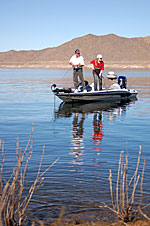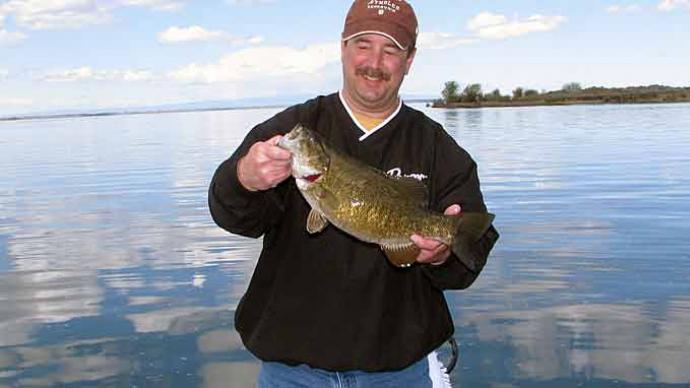
Often mentioned but rarely explained, "establishing a pattern" is a goal of every serious bass angler. While the term pattern suggests some visible cues that lead the angler to narrow their approach to catching, many pros, with years of experience appear to skip steps or make assumptions that newcomers just can't.
The following includes some thoughts on the matter.
First, a good question might be, "What is a pattern?"
In my opinion, a pattern is evidence of repeat bass behavior in a given period. But here's the rub. It's about their behavioral patterns but from our perspective.
In other words, bass don't suddenly have a yearning for brown and purple jigs or hollow body swimbaits during a three or four-hour period. It's usually a matter of us applying our wares to what we presume the fish are doing.
Bass may be active, even feeding, in an area with a particular topography, cover, or bait availability. However, the angler sorts through his various tool options, positions his boat and makes the presentations to complete the package that gets the fish--that process is what we recognize as pattern fishing.
To be sure, a pattern may be so refined that it gets down to a 4-pound test fluoro, tandem-rigged Sworming Hornets fished parallel and tight to the shoreline before 7 a.m. Still, in many waters and many other situations, the fish may not require so many stipulations. But you won't usually know that immediately, even armed with recent information. Day-to-day changes may forge slight variations in the fish's behavior, which may require adjustments on your part.
When fishing "strange" water, you often have to rely much more on your powers of observation and understanding, but that exercise will serve you well over the long run. After all, establishing a pattern is based on gathering information while on the water and then acting on it.
One other note. Everyone needs a place to start their search, and that usually comes from what the bass texts refer to as "seasonal patterns." Bass tend to do certain things at certain times of the year. It's not a perfect science, but it gets you closer than you would be standing on the launch ramp. If you want more thoughts on seasonal patterns, the Internet is full of discussions on seasonal patterns--BassResource.com being a great place to start.
The Best Information

For my money, the best information for establishing a pattern comes from "bites." If you have a trusted fishing partner with some experience who tells you he got a bite, that may work for you. But nothing speaks better to me and my quest than a bite that I get at the end of my line.
Somewhat like remembering your first kiss, first car, or first bass, some experiences have a certain indelible quality. Admittedly less meteoric but still critical in confidently pursuing bass, those things you experience (see, feel, learn, even sense) while you're out there matter the most. This is the best kind of information there is.
I say bites, not necessarily hooked fish, because realistically, I'm looking at acting on a minimum amount of information I might be able to gather. Heck, if you hook three seven-pounders on your first five casts with a spinnerbait on the riprap next to the launch ramp, establishing a pattern is virtually a done deal.
But don't we all know it usually doesn't come together so easily. Hooked fish are good, but so, too, are nips, "short bites," visible strikes, flashes, or following fish. I will go so far as to say sometimes, even catching an unintended species, such as a crappie or catfish, can offer up clues. Remember: they've got to eat, too. Chances are they shop at the same quick marts as the bass.
As for getting those bites, however, you have to understand there is more than one way to proceed. Whatever method an angler is most comfortable with to get that bite is the one to commence with. If you drop-shot or Texas rig most often, start with those methods; don't try to become Kevin VanDam and power fish with baits you need to become familiar with. Plastic worms have the edge over many lure types in that fish of all sizes tend to bite them. The issue with most plastic worm methods is they don't cover water quickly, so you need to understand their limitations.
Personally, when it comes to bass fishing, I always liked that line in the movie "Midway" where the bomber squadron leader tells his flight, "Get in close and get hits." Bites are everything because they indicate that you have found fish that are interested or, at least, reactive. This is good.
But if you pay attention, you'll get all the details.
Observation Critical

Because patterns are sometimes veiled in occurrences that may or may not have anything to do with what the fish are doing, you need to be a critical observer in your pattern search. Yes, you may find bass on steep, east side walls, hitting 5/16-ounce, black football head jigs, on 12-pound test, green mono in 15 to 18 feet of water after 10 a.m.
There may also be some froth on the water, egrets standing 10 feet apart on the bank, nothing showing on sonar, red-winged blackbirds chirping in the reeds, and two yellow pickup trucks in the parking lot beneath a sky marked by cumulus clouds fanned by winds blowing lightly out of the South--on a rising barometer.
Some of these things may matter, and some won't. Note them, if you will, but don't necessarily attribute them to your pattern. You could go to the next spot, and the pickup trucks are metallic blue!
Now, assessing any bite becomes even more critical if you're not catching or not catching like you think you should be.
You want to note the depth of the strike, the speed of the retrieve when it occurred, the angle of the cast, or where in the cast/retrieve that bite came. For instance, did it come when the lure first hit the water? Or was it much later? Most veteran anglers can describe a time when they were carefully and quietly pitching their slow-falling baits for an hour, but they didn't get any reaction until a fish swirled on their offering as it was being lifted out of the water.
That's a clue, baby.
Likewise, always be watchful of water clarity changes, a riffled surface, or the presence of shade. Or, in the case of hooked fish, was it hooked lightly, did it knock the bait off track or thump it, or did it come after some preceding action such as a short bite, swirl, or interruption of the retrieve?
Like the kid tugging on your pants leg at the carnival, they're trying to get your attention.
Adjustment Time
The third part of establishing a pattern is adjusting to what you encounter. We've all been frustrated by fish showing themselves but not seeming to want what we have to offer.
That kind of behavior is a pattern too!
Over the many years of covering the U.S. Open out on Lake Mead in the Nevada desert, I have heard the story a hundred times of bass jumping over topwater baits but not taking them--accounts of 10 or 20 such strikes in a day, but only half empty sacks to show for them.
You can't let your ego get the best of you. If you cannot solve this fish behavior with varied approaches, you need to find a pattern you can rely on before the weigh-in. As much as we would like to believe otherwise, it is an absolute myth that the bass can always be made to bite. However, what is more, likely true is that some bass (somewhere in the lake) can be induced to strike, and those are the ones your patterning search will help you "figure out."
By most accounts, lure choice should be your last adjustment, not your first. If you can draw a strike with what you have tied on, then the "secret" of catching them is probably more connected to your presentation. Angles are much more critical than anyone gives them credit for. Bass relating to a piece of cover do so for a reason. It best suits them for foraging or protects them from where they feel most threatened. When feeling aggressive, they may be willing to commit. However, the bass often have a preferred angle of attack--for a specific location.
This is almost always the case on isolated cover off the banks. But many times, that attack angle of the feeding fish would be one funneled into cover. Still, since bass anglers usually cast toward the shore and retrieve away from that cover, they often miss as many as half of the available presentation options. That could be a factor to address.
Of course, the speed of the retrieve or some variation thereof could be the critical issue. You can use your baseline retrieve speed or presentation method as a starting point, and go from there. Sometimes "too fast" (from our previous experiences) is just right today. But whatever changes you make, do so systematically, so you'll be able to recognize the fish's response--and not have to guess.
After speed, lure color, or lure size, whether in reaction baits or the soft stuff, can be a factor--and one more quickly addressed by two fishermen working in concert. Once something clicks, narrowing it down goes even faster.
Whether it is terrain, sun angle, cover, forage availability, depth and speed of your retrieve, or any combination of these or other factors that start to produce fish, that is the template for catching them in other like areas with similar conditions. Pursue that course until it fades, which is the essence of pattern fishing.



